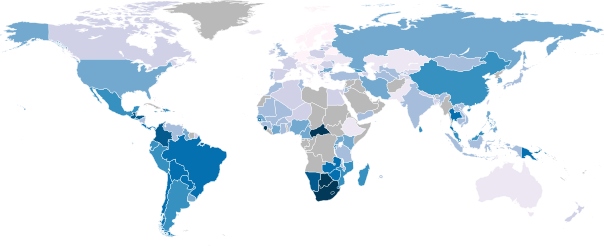The Gini coefficient (named after its inventor, statistician and sociologist Corrado Gini) measures the income distribution of a country’s population. It is often used as an analogue for measuring inequality within a population in general.

A map coloured by Gini coefficient. Darker blues represent higher Gini coefficients (greater inequality).
A Gini coefficient of zero represents perfect income equality (everybody ears exactly the same amount) and a Gini coefficient of one represents perfect inequality (one person in the population earns all the money). Denmark has the lowest Gini coefficient (0.24) and the Seychelles the highest (0.66); the UK has a Gini coefficient of 0.34 and the US 0.45.
Consider three hypothetical ten-person countries:
| Country | Randomland | Inequaliteria | Equalistan |
| Citizen #1 | 49755 | 500000 | 50000 |
| Citizen #2 | 61429 | 10 | 50000 |
| Citizen #3 | 80411 | 10 | 50000 |
| Citizen #4 | 45021 | 10 | 50000 |
| Citizen #5 | 68466 | 10 | 50000 |
| Citizen #6 | 96746 | 10 | 50000 |
| Citizen #7 | 18788 | 10 | 50000 |
| Citizen #8 | 71039 | 10 | 50000 |
| Citizen #9 | 79777 | 10 | 50000 |
| Citizen #10 | 10258 | 10 | 50000 |
| Gini Coefficient | 0.250 | 0.900 | 0.00 |
Another way of measuring income inequality is the Robin Hood index, which indicates the portion of a country’s total income that would need to be taken from the richest half of the population and given to the poorest half of the population in order to achieve income equality. For Randomland the Robin Hood index is 18.71%, for Inequaliteria it is 90% and for Equalistan it is 0%.